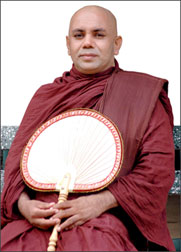Taming the mind through meditation
by Sajitha Prematunge
[email protected]
|

Ven. Bandarawela Amithananda Thera
|
I felt like I had to touch base. No Buddhist or for that matter any
person of any religion can ignore that nagging need to reconnect with
that spiritual side of life once in a while, and I felt I had been
disregarding it for too long. Vesak for me, couldn’t have come at a
better time.
My mind ran back to an interview I did with Ven. Bandarawela
Amithananda Thera a few months ago, that I kept putting off since I
wanted to take all the time I needed to do a good job with it. I
wouldn’t know if I have succeeded in doing so, but I hope our readers
would benefit from it.
Meditation
“The minds of the lay, filled with craving, is restless.” Said
Bandarawela Amithananda Thera, explaining the significance of meditation
for monks and the lay alike. Some seem to believe that ‘meditation’ was
not meant for the lay. But Bandarawela Amithananda Thera explained that
meditation is a must to relinquish the dukka (unsatisfactoryness) for
the monks and lay alike, that’s born out of the restless mind.
“Meditation is the only way to tame the mind.” He explained.
“There are two main categories of meditation Samatha and Vidharshana,
and 40 methods.” He explained. “Samatha is a temporary form of mind
control, administered in consideration of ones position in the society,
ones caste, etc.... Vidharshana is to observe things are as they are and
is a long term solution to the troubled mind.
|

Pix by Nisansala Karunaratne |
In the Maha Sathipattana Sutra - which represents the real essence of
Buddhism - the Buddha explains three stages of mind; Soka, Paridewa,
Samathikkamaya. Soka is the restlessness of mind. “One can only
relinquish the restlessness by renouncing the indulgence of entertaining
the five senses.”
Instead most humans through Upandana (holding on), clutches on to the
Raga (desires). Paridewa is the subsequent propagation of restlessness.
The way to relinquish the restlessness is Samathikkamaya, to go beyond
Raga without holding on to them.
According to the Buddha “If restlessness arises out of something -
which is termed as a nimitta - one should go beyond that nimitta by
thinking of anithya (transience of life), dukka (unsatisfactoryness due
to transience) and anathma (soullessness).” This is the beginning of
Vipassana meditation.
“When the mind is restless, suffering increases and vice-versa.
Consequently it is a never ending cycle.” explained Amithnanda Thera
reiterating the fact that one should not clutch on to desires. The
Buddha in the Maha Sathipattana Sutra preached that the person who has
mastered the art of breaking this cycle will be successful in attaining
Nibbhana.
Consciousness
“One must always be conscious of everything.” One must always be
aware of every thought that crosses the mind. They must be alert and
aware. For example, if anger arises, the person must be aware that he or
she is angry before he or she could remedy it. For which, each person
must be aware of the workings of the mind.
Thereby perceive the pain caused by anger to ‘oneself’, let alone
others. Just as negative emotions like anger causes negative sensations
- Akusala dhamma, the sensations that arise out of positive emotions are
positive - Kusala dhamma. Dhammanupassana relates to bearing positive
thoughts in the mind, thereby generating positive sensations in the
mind.
This alertness and analysis of thoughts, has been termed as
Anupassana. Consequently the alertness is four folds - kayanupassana,
vedananupassana, chittanupassana and dhammanupassana. “You must be aware
of everything that happens concerning mind and body.” One must calm the
mind by this analysis enough to perceive each and every thought that
crosses the mind.
Yogawachara
According to the Maha Sathipattana Sutra the mind of the person who
has mastered this art - Yogawachara - is devoid fear and suspicion. As
the first step, the mind of the untrained lay person is compared to a
dense forest, always in fear and suspicious. But through anupassana the
mind can be gradually trained, until it reaches the second step.
The Sutra compares the second step to obtaining calmness of mind as
resting on the root of a tree, fear is gradually reduced and the mind
begins to settle.
The third stage of the mind in training is compared to an old house
stripped of furniture. Raga (desires), dosa (malice) and moha
(ignorance) is gradually stripped away like the furniture, permitting
him to look within himself. This is the first step to becoming a
Yogawachara.
Anapanasathi
“From 4 am to 12 midnight people are always busy. They are always
running.” But Anapanasathi does not take up time. Most people seem to
believe that the Anapanasathi is not a suitable form of meditation for
the lay person.
Often the desired results are not reached through this particular
form of meditation, because people do not follow the proper method. “Do
not meditate without the assistance of a teacher.” said Amithananda
Thera.
“Breath must not be merely seen but observed properly. And where and
how the breath is transferred through the body is not what is important.
What the meditator must focus on is the simple fact that it’s happening.
The meditator must be ‘aware’ that he or she is ‘breathing’.”
The person who has trained the mind is able to inhale and exhale
consciously. “While engaging in Anapanasathi, one must also be conscious
of the fact that life depends on ‘breath’ and not money.” If one
accomplishes this he can acquire consciousness of Anithya, dukka,
anathma.” The lay has over sixty types of desires, and the mind clutches
on to them.
Minds of people with this many desires can never be tamed with only a
few hours meditation. “People move from one meditation centre to the
next, after meditating for just a few days, in search of the ‘best’
meditation centre.
Mind will never be tranquil enough to meditate if people do not
comprehend the fact that life is about conflicts and attachments, one
must train the mind to not clash with the dislikes and get attached to
the likes.”
In Buddha’s own words “Take what you see, what you hear, what you
feel for just what they are. Do not clutch on to them.” |
